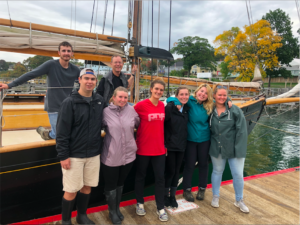Following our second stay in Wells, we returned to Portland before catching the ferry for a week on Peaks Island in Casco Bay. Once on Peaks, we observed the changes in wave energy affecting the island around its perimeter. To the north, south, and west of the island, neighboring islands and the mainland mostly protect its shores from the open ocean. On the east side, however, distant swells are able to impact the island due to its large fetch. Fetch is the horizontal distance of ocean surface over which the wind blows and wind-driven waves are formed. The varying wave energy received by the shores of Peaks Island is evident in the distribution of sediments. On the protected west side, beaches are found with predominantly sand and other fine sediments. On the unprotected east side, powerful wave action results in much larger sediments, such as cobbles and even some boulders. The rest of the time spent on Peaks Island was filled with textbook reading and lectures to prepare us for the next ESS adventure: nine days aboard a schooner.

For the first day, we boarded the 94-year-old, 72′ schooner Bagheera (yes, named after the black panther in The Jungle Book) for a day sail around Casco Bay to learn how to operate the equipment to be used for the 80-nautical mile voyage to Port Clyde. For sampling the water column, we used a CTD sonde and Van Dorn bottle to determine salinity, temperature, dissolved oxygen, and pH at several depths. To analyze the sediments on the sea floor, we used a Ponar dredge or a coring device to bring samples up to the deck. At the end of the day, we returned to Peaks Island to pack and get some rest before setting sail.

The next morning, we were up bright and early to load our gear onto Bagheera. We then disembarked for our first full day on the open water. After stopping to record a few samples, we arrived at Jewell Island for our first night. Jewell Island, inhabited by the U.S. military in both WWI and WWII, is home to an extremely large tide pool known as the Punchbowl. With a calm tide pool before us and the crashing open ocean beside us, we learned about the relationship between wave energy and sediment transport. We also learned about how waves refract as they encounter a headland, a cove, or shallow water near shore. After dark, Dr. Erikson lead us to one of the island’s artifacts of WWII: a German U-boat lookout tower. With headlamps on, we ascended the tower to the highest floor, where the city lights of Portland could be seen in the distance. The next morning, we continued our journey up the coast, learning along the way.

-Jarrett Beaulier


 After a few photos, we continued our journey north to Calais where we crossed the international border into New Brunswick, Canada. From there, we pushed eastward into Saint John, NB to grab a bite to eat before arriving at our destination of Fundy National Park in the late evening.
After a few photos, we continued our journey north to Calais where we crossed the international border into New Brunswick, Canada. From there, we pushed eastward into Saint John, NB to grab a bite to eat before arriving at our destination of Fundy National Park in the late evening. The extent of the boreal forest sits around the northern hemisphere’s subpolar low pressure zone; an area characterized by cloudy skies and lots of precipitation. Amongst the forest was a peat bog. Peat bogs are formed when layers of moss grow upon one another atop stagnant water. The constant moist and low-oxygen conditions prevent decay, allowing new moss to grow on top of old, dead moss, resulting in meters of layered peat. After some time in the forest, we returned to the campground to finish some homework.
The extent of the boreal forest sits around the northern hemisphere’s subpolar low pressure zone; an area characterized by cloudy skies and lots of precipitation. Amongst the forest was a peat bog. Peat bogs are formed when layers of moss grow upon one another atop stagnant water. The constant moist and low-oxygen conditions prevent decay, allowing new moss to grow on top of old, dead moss, resulting in meters of layered peat. After some time in the forest, we returned to the campground to finish some homework. To evaluate the ancient climate, we had to look specifically at the sediments within the layers. The majority of the layers contained large river deposits, suggesting the area was characterized by exceptionally wet, and potentially tropical, conditions. We later learned that the region surrounding Hopewell Rocks was located in the tropical region of an ancient supercontinent around the time these deposits were made, confirming our hypotheses.
To evaluate the ancient climate, we had to look specifically at the sediments within the layers. The majority of the layers contained large river deposits, suggesting the area was characterized by exceptionally wet, and potentially tropical, conditions. We later learned that the region surrounding Hopewell Rocks was located in the tropical region of an ancient supercontinent around the time these deposits were made, confirming our hypotheses.